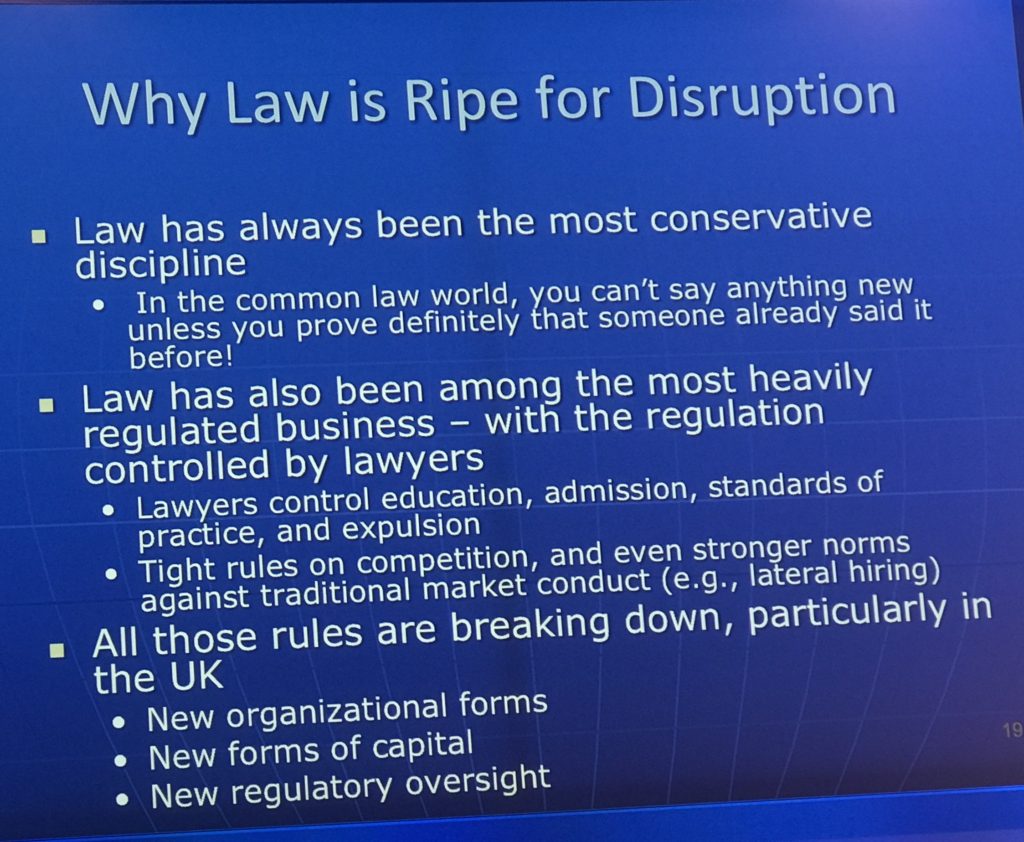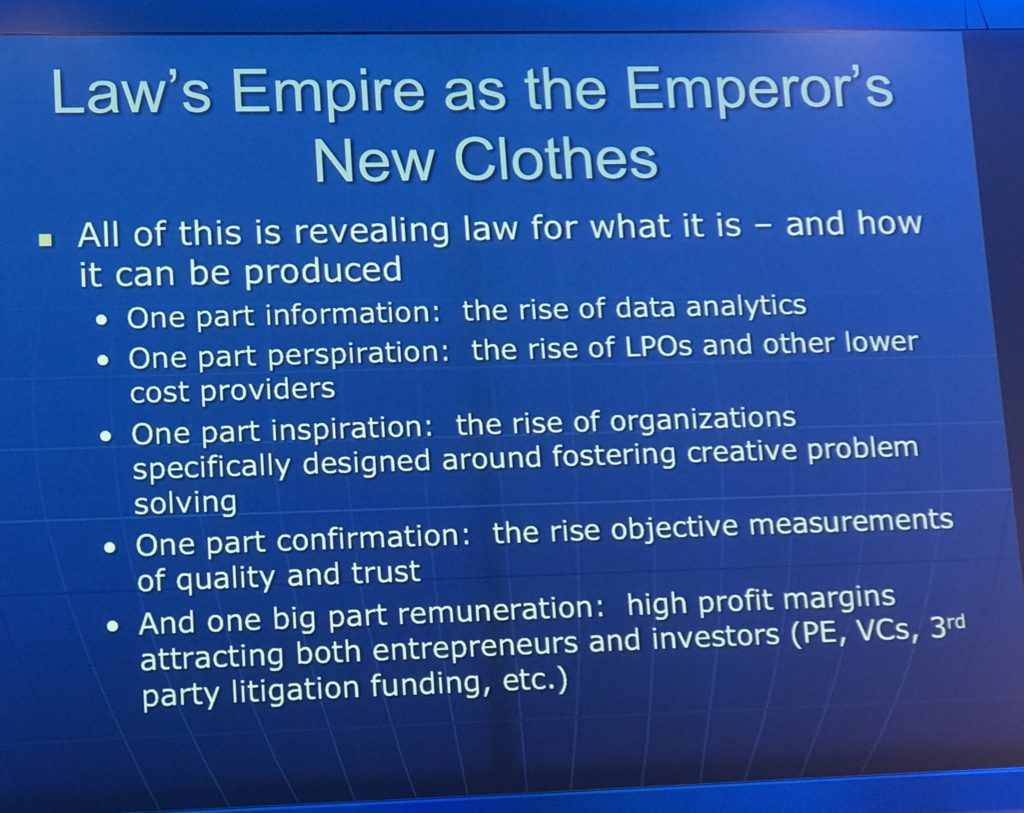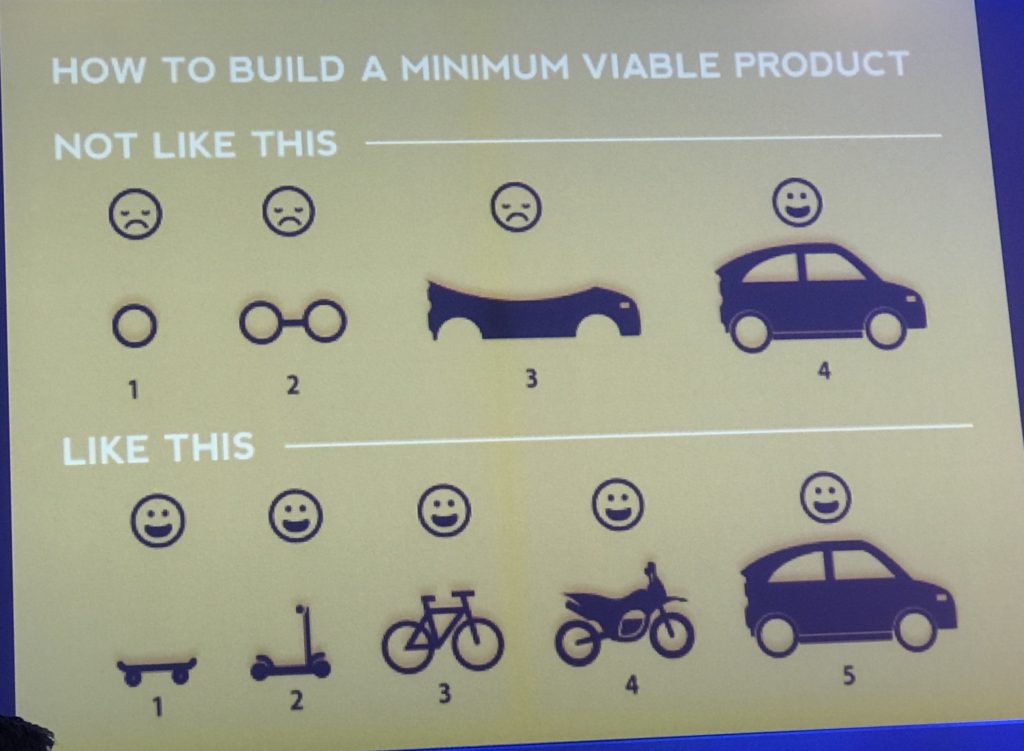This is a live blog post of The Future of Legal Services in the Global Age of More for Less. Professor David B. Wilkins (Harvard) is the presenter.
I am posting live from Lexpo 2017, a legal innovation event in Amsterdam on May 8-9, 2017. I post as a session ends, so please forgive any typos or errors in my understanding. The session description appears at the end.
Question since 2008 has been “Are we in a paradigm shift? Is Big Law dying”. Even more apocalyptically, is it the end of lawyers (reminded by Richard Susskind that it is followed by a question mark). Points out that 1991 law grads had a harder time finding jobs than 2009 grads.
Wilkins says “Who knows”. The truth is that is too early. Since 2009 crash, macro trends in motion already at that time are continuing. Wilkins says that collectively, these forces are fundamentally reshaping the global market for legal services. The structural changes include the globalization of economic activity, the rise of information technology, and the blurring boundaries of traditional categories of knowledge and organization. The latter includes that companies may not be all public or all private.
The consequences of the structural changes has several impacts. First, the reduced information asymmetry between buyers and sellers has changed who has power in commercial relationships. It has also led to the unbundling and repackaging of services throughout global supply chains. Wilkins uses as an example music: in the past, consumers had to buy LP albums with 16 songs to get the one song they wanted. Today, with downloads or streaming services, consumers can get exactly what they want. Today consumers get what they want, when they want.
Second, in the past, you had to buy products on the basis of reputation and “inputs”. Today, there is much more reliance on external metrics. “The move from reputation and credentials to value as measured by metrics”. Cites as an example cars. In the past, buyers had to rely on name plate and apparent components. Today, buyers rely on a range of third party rating services. Cites the examples of doctors. In the past, reputation was the only source of information. Today, a range of rating services allows comparing doctors outcomes, number of procedures, and other metrics. As a result of the medical metrics, we have seen a rise of medical tourism. The data show some hospitals in India have outcomes as good as best hospitals elsewhere.
Third, the unit of analysis moves from firms to networks. Cites as example the iPhone and Apple. The iPhone is a result of a network: multiple companies contribute to design and manufacture. Book “Wealth of Networks” argues that in 21st C., networks create value.
With all these changes in economy, why wouldn’t law change? Law is a lagging indicator, not a leading one. So it makes sense that legal market would change. The consequences for law firms are several. First, we see the “efficient unbundling and repackaging of services and a move toward ‘value billing.”
Second, there is a range of new disruptors. To some extent, law firms going global has disrupted local law firms. LPOs and multidisciplinary professional service firms disrupt as well.
In the past, rate increases and leverage drove law firm profits. These drivers will likely become far less important in the future, “particularly when demand is relatively flate at 0.5%”. Another big change is that clients are reducing their demand for in-depth, traditional bespoke services; the will settle for less. (RF: sounds like one of my favorites, DoLessLaw.)
As an example, Wilkins cites example of buying bespoke suit on Seville Row. While you will look fabulous in that suit, it is super expensive. Buyers reconsider how often they need to spend so much. Legal services cannot always cost as much as bespoke suits, so to speak. Clients do not have legal problems – they have business problems. They want to spend less on law.
Though clients want to spend less per problem, the good news is that there are many more legal problems to solve today. But to succeed, law firms must understand the client the way they want to be understood.
Furthermore, “the old normal has not been repealed”. Law remains a people business. For the foreseeable future, law remains a human capital business. Wilkins does not see robots replacing lawyers anytime soon. Moreover, clients mainly don’t want to talk to robots. For judgments and decision making, clients want relationships with people. Evidence for the importance of relationships is the big trend to convergence (reducing the number of law firms). Points out that at one time, companies had one outside law firm. Then a new generation of GC broke up the monopoly. Then, with hundreds of law firms, none knew the business. Now, the pendulum swings back to a smaller network that knows the company and that is willing to share risks and benefits. If clients get the kind of services they want, they are happy to pay for it.
“Tradition and stability continue to have important value for lawyers and clients.” We will therefore never see complete deregulation. And it will remain true that it will take a long time to become expert lawyers. Expertise does not exempt lawyers from the rules of change. Nor does it mean that 22 year olds playing fussball can replace them, referencing the tech business.
So how do we align the old with the new? On the people side, it remains a challenge to attract, develop, and retain top talent. On the tech side, firms do need to find the right tools to arm lawyers. And explore what tasks machines can do (replacing people). On structure, firms must create an environment where multiple professional collaborate in a way that crosses boundaries. (RF: a knock on the caste system.)
[Wilkins now turns to the empirical evidence. His program at Harvard has collected a lot of market data. Data include focus groups, interviews, and surveys of S&P 500. Has assembled chief innovation officers and legal ops specialists in law firs and companies. Defining quality metrics. Documenting reemergence of Big 4. You can read all about this work at https://thepractice.law.harvard.edu/ (subscription required)].
Returning to the issue of aligning people.. at one time, law firms recruited good-looking Nordic men (quoting a 1960s book). Today, we have much more diversity. 50% of law students are women. But the career path in law firms is still designed for men with wives who work at home. Furthermore, we have much more ethnic, racial, and geographic diversity. And lawyers increasingly need to work with other professionals. Wilkins knocks the use of phrase “non-lawyer”. To solve complex legal and business problems will require diverse teams of people and disciplines.
More people issue… age ratios. In 1970 there were 100 lawyers 50+ to 127 younger. In 1985, it was 100 to 284. But in 1990 it leveled off and by 2005 it was 100 to 126. By 2020, it will be 100 to 104. What is the impact of this? It leads to three problems: (1) How do firms transition older partners (Baby Boomers). Especially with many viewing 60 as the new 40. In the past, partners would often step aside at 55. (2) It’s a challenge to adapt to Millenials. The issues with them is not what many think it is . Millennials are more focused on global issues and problems. They want to be motivated; they want to feel included; they want a sense of meaning. (3) Firms need to manage “culture wars” among different generational points of views.
In response to the war for talent, we need to create institutional “nudges” to provide the right incentives. (RF: on nudges, see Richard Thaler). Top down policies rarely work. Yet law firm leaders must set clear priorities. Those policies must align with overall strategy and goals. All this requires a systematics approach to hiring and development that benefits all lawyers. Hiring must be standaridized and transparent. Grades should not matter nearly as much. Separate subjective from objective criteria. Interviews should be in a team context to eliminate subjective bias. Firms must also equalize work flow. Millennials especially sensitive to unequal allocations. Firms must get better at evaluating the operation and performance of teams.
Talent does not stop with new lawyers. Partners need PD as much or more than associates. Succession is the number one challenge for most law firms. Succession issues are not just at the top – also at practice level. And law firms must move to evaluating leaders on metrics and structure, not individual performance.
For associates, firms need a better approach to managing associates. Leaving will likely happen. But firms should manage this, encouraging longer stays and happier departures.
Turning to tech… why do law firms need it? Today, knowledge resides in heads of lawyers. Current model depends on senior lawyers sharing know-how. We need a way to pass on the know-how.
Disruptive innovation… occurs when existing work patterns are radically transformed quickly. New competitors establish foothold and move upmarket. Cites DEC and Wang being replaced by Microsoft and Apple. The only tech survivor among tech companies has been IBM, which disrupted itself with PCs. Now IBM is at it again with Watson. Explains origin of Watson and deployment in oncology.
On AI, law is more like chess than it is like Jeopardy. Chess is very hard but totally bounded, so not surprsing a computer won. When Watson won Jeopardy, that was a bigger deal because language is not bound.
So law may be ripe for disruption (capturing slide – can’t keep up):
Disruption has already begun – with the Big 4. They have not been accounting firms for decades. There were big bumps 15 years ago but they are back. Calling them multidisciplinary is understatement. They consider themselves global solution creators.
GCs have many challenges: cybersecurity, anti-bribery, catastrophic risk. But they face regulatory overload. Law firms are not really designed to meet these needs. Law firms are optimized for deep, narrow expertise. But companies need broad, multi disciplinary solutions. This creates unbundling, coordination, and re-bundling (integration). Law firms that can do this will win.
To stay ahead of disruption curve, law firms can… Do sustaining innovations. These allows incumbents to better serve clients. But may also block real innovation and change. Firms should also pay attention to disruptive innovations: new tech and methods will create new market, which transform old markets. This may require firms to switch markets. Three keys to adapt: when valued should bc created, with whom value can be creates, and how to measure whether value has been created.
Law firms need to move from finished products to intermediate products. Provide satisfaction all along the way. Adopt the approach of minimum viable product throughout the legal representation. Shows student slide that illustrates;
Firms face a triple squeeze. Clients demand more for less. Multiple competitors. War for talent.
Partners must respond by creating a one firm culture. They need to express that culture both externally and internally. Cultivate and learn from the stars but foster the team. Collaborate not just internally but also across organizational boundaries.
Session Description
“In this talk, Professor Wilkins will identify the key trends reshaping the global market for legal services, and discuss how the best law firms and in-house legal departments are responding to these challenges. The talk will incorporate original research about the practices of firms and companies in both mature and developing legal markets, and will identify concrete steps that leaders of these organizations can use to drive innovation and change that provides real and measurable value to clients, to professionals, and to society.”

Archives
Blog Categories
- Alternative Legal Provider (44)
- Artificial Intelligence (AI) (57)
- Bar Regulation (13)
- Best Practices (39)
- Big Data and Data Science (14)
- Blockchain (10)
- Bloomberg Biz of Law Summit – Live (6)
- Business Intelligence (21)
- Contract Management (21)
- Cool Legal Conferences (13)
- COVID-19 (11)
- Design (5)
- Do Less Law (40)
- eDiscovery and Litigation Support (165)
- Experience Management (12)
- Extranets (11)
- General (194)
- Innovation and Change Management (188)
- Interesting Technology (105)
- Knowledge Management (229)
- Law Department Management (20)
- Law Departments / Client Service (120)
- Law Factory v. Bet the Farm (30)
- Law Firm Service Delivery (128)
- Law Firm Staffing (27)
- Law Libraries (6)
- Legal market survey featured (6)
- Legal Process Improvement (27)
- Legal Project Management (26)
- Legal Secretaries – Their Future (17)
- Legal Tech Start-Ups (18)
- Litigation Finance (5)
- Low Cost Law Firm Centers (22)
- Management and Technology (179)
- Notices re this Blog (10)
- Online Legal Services (64)
- Outsourcing (141)
- Personal Productivity (40)
- Roundup (58)
- Structure of Legal Business (2)
- Supplier News (13)
- Visual Intelligence (14)



